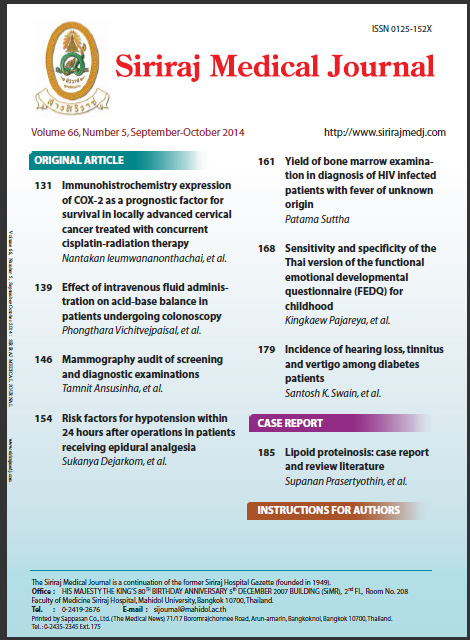Mammography Audit of Screening and Diagnostic Examinations
Abstract
Objective: Mammography has been recognized as the gold standard for screening breast cancer. To achieve the effectiveness of mammography performance, mammography audit is recommended as a method for evaluating the accuracy of mammography interpretation. This study aimed to evaluate the key parameters of screening and diagnostic mammography audit in our dedicated breast imaging center.
Methods: Retrospective analyses of 54,204 out of 64,049 mammography with or without breast ultrasound at Thanyarak Breast Center, Siriraj Hospital, Mahidol University during 1 Jan 2001 to 31 Dec 2005 were performed. These comprised of 26,735 screening (SCR) and 27,469 diagnosis (DX). Demographic data, image assessment category, biopsy results and mammography audit were analyzed base on BI-RADS (4th edition) recommendation.
Results: The mean age of SCR group was 50.1 years compared to 46.2 years for DX. Family history of breast cancer found in SCR and DX were 9.9 and 10.9%. The positive predictive value (PPV2 or biopsy recommended) were 19.5% and 33.7% in SCR and DX respectively. The cancer detection rate (CDR) in SCR and DX were 3.8 per 1000 and 40.0 per 1000. The sensitivity/ specificity in SCR and DX were 73.6%/98.4% and 96.3%/ 75.1 % respectively.
Conclusion: Significant difference key parameters among SCR and DX mammography were well established. Our study represents key parameters of mammography audit of SCR and DX of Thai women comparing to other reports. However, variation in these key parameters of mammography audit depends on definition when comparing to other institute outcomes.
Keywords: Screening mammography, diagnostic mammography, mammography audit, Cancer detection rate (CDR), key parameters
Published
How to Cite
Issue
Section
License
Authors who publish with this journal agree to the following conditions:
Copyright Transfer
In submitting a manuscript, the authors acknowledge that the work will become the copyrighted property of Siriraj Medical Journal upon publication.
License
Articles are licensed under a Creative Commons Attribution-NonCommercial-NoDerivatives 4.0 International License (CC BY-NC-ND 4.0). This license allows for the sharing of the work for non-commercial purposes with proper attribution to the authors and the journal. However, it does not permit modifications or the creation of derivative works.
Sharing and Access
Authors are encouraged to share their article on their personal or institutional websites and through other non-commercial platforms. Doing so can increase readership and citations.











